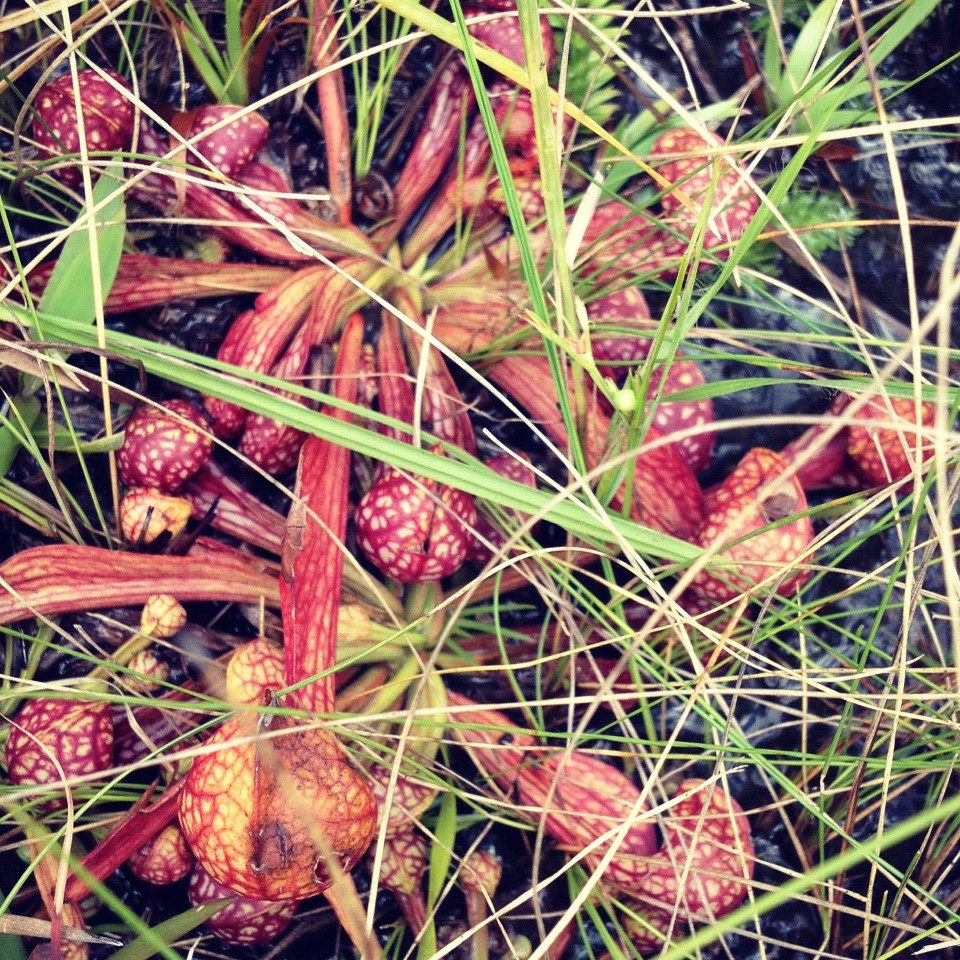
by Carrie Stevenson | Apr 30, 2020
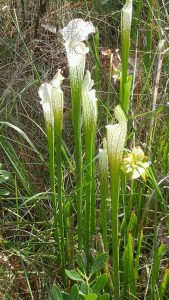
White-topped pitcher plants in bloom at Tarkiln State Preserve. Photo credit: Carrie Stevenson, UF IFAS Extension
If you live in northwest Florida or southeast Alabama and have never laid eyes on our wild native carnivorous plants, it is about time! April and early May are the best times to see them in bloom. We have six species of pitcher plants (Sarracenia), the most common being the white-topped (Sarracenia leucophylla). However, they come in multiple colors, from yellow and red to a deep purple, and in different sizes.
One thing they all have in common, though—they eat meat. Carnivorous plants all over the world have evolved in places that left them few other options for survival. These plants are typically found in extremely wet, acidic, mucky soils with very low nutrient levels. Normally, plants uptake nutrients like nitrogen and phosphorus from the soil around them. Not being available in these particular environments, carnivorous plants (or more specifically, insectivorous) developed a way to extract nutrients from insects.
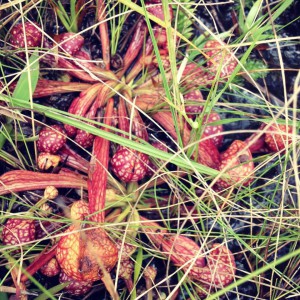
Small parrot pitcher plants lie on the ground instead of standing upright at Blackwater State Forest. Photo credit: Carrie Stevenson, UF IFAS Extension
So how does it work? Pitcher plants have a modified leaf, which instead of lying out flat like most plants, is rolled up into a tube, or “pitcher” shape. The inside of the pitcher has a sweet sap, and the walls of the tube are lined with tiny, downward-pointing hairs. Separate from the leaf, the plant has an elaborate flower structure, which attracts insects for pollination. While nearby, these insects are also attracted to the colorful leaf and the sweet sap in its pitcher. The insect will land on the lip of the leaf, then crawl down.
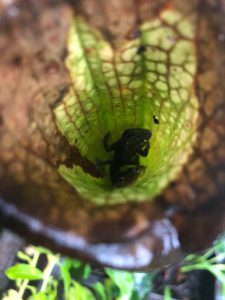
A lizard waits patiently a the bottom of a pitcher plant, hoping to catch insect prey. Photo credit: Carrie Stevenson, UF IFAS Extension
Those sticky, downward facing hairs are a trap, preventing insects from leaving the pitcher. Enzymes—a cocktail of proteins naturally found in many other plants but used creatively here—in the sap break down the bug bodies and convert them to nutrients for the plant. In fact, if you slice a cross-section into a pitcher wall or break open a dried one, you will see countless dried exoskeletons at the bottom of the tube. Several other enterprising species have taken advantage of the pitcher plant’s creative structure. More than once, I have seen tiny spiders spin webs across the mouth of the tube, or small lizards and frogs at the bottom, waiting patiently for prey.
Some of the best places to see pitcher plants in the area—they also bloom in October—are Tarkiln Bayou State Preserve, Weeks Bay National Estuarine Research Reserve, Splinter Hill Bog Preserve, and Blackwater State Forest.
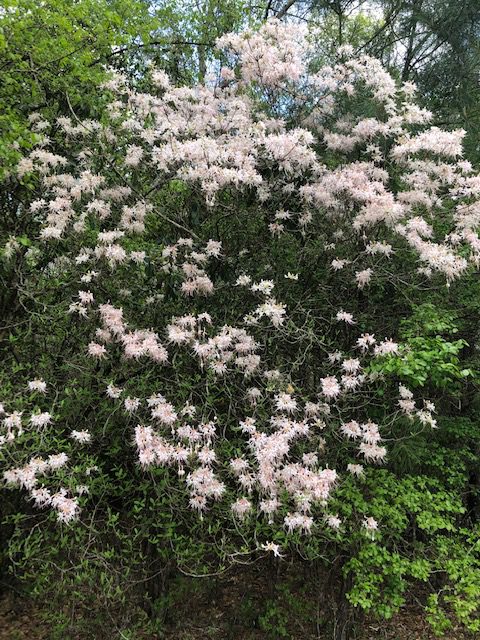
by Carrie Stevenson | Apr 15, 2020
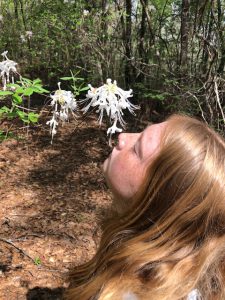
The sight and scent of a wild azalea blooming in the woods can stop you in your tracks! Photo credit: Carrie Stevenson, UF IFAS Extension
From a distance, native azaleas are easily mistaken for honeysuckle vines. With long, arching stamens, you might be tempted to relive your childhood, hoping to pull the pistil from the bottom and find a single drop of sweetness on the end. Instead, upon close observation you will encounter an equally pleasurable but distinctly different scent. The wild Rhododendron canescens, known variously as a mountain, piedmont, or honeysuckle azalea, can range in flower color from white to deep pink. In northwest Florida, you will find it on the edges of swamps, or as I did on the sunny fringes of wooded areas with rich, moist soil. It is in bloom right now (March), along with its cousins, the white-blooming swamp azalea (Rhododendron viscosum) and the brilliant orange Florida flame azalea (Rhododendron austrinum).
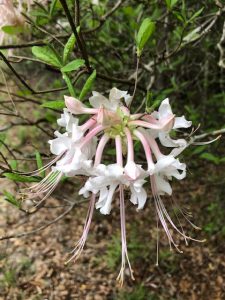
The delicate flower of a honeysuckle azalea attracts hummingbirds and butterflies in the spring. Photo credit: Carrie Stevenson, UF IFAS Extension
Native azalea populations have declined due to wetland habitat loss, and their delightful smell and delicate flowers have made them susceptible to overcollection. Due to these factors, the Florida flame azalea is listed on the state endangered species list and wild azaleas should never be removed from their habitat. Native azalea species attract butterflies and hummingbirds, and are often planted in home landscapes as ornamental shrubs. Be sure you purchase them from reputable dealers that are not collecting from the wild.
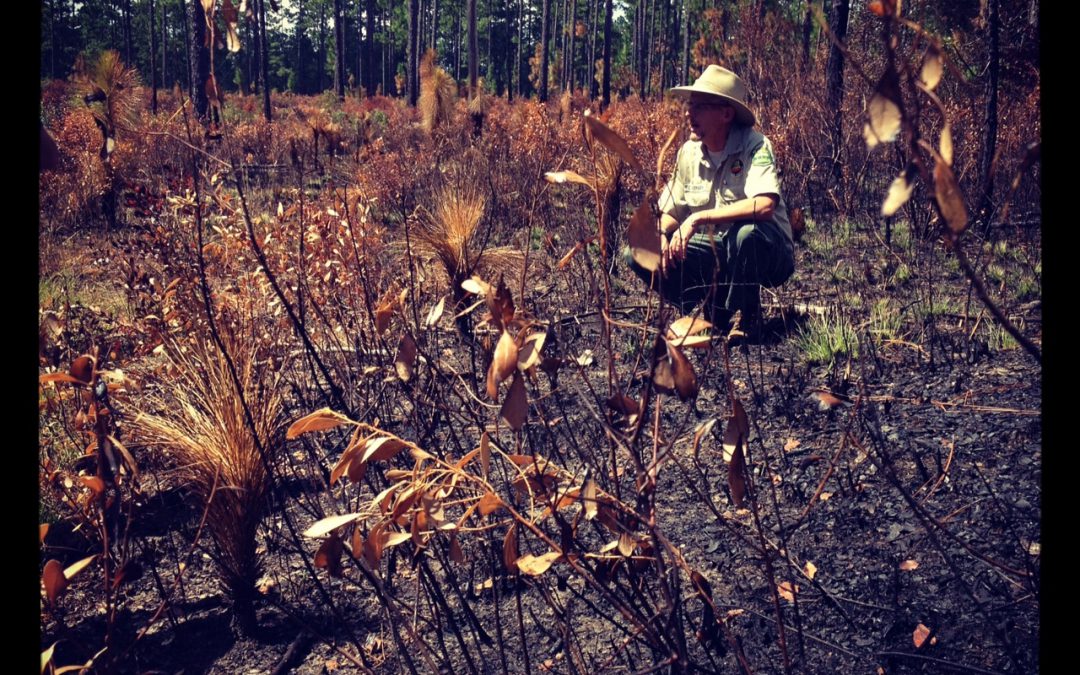
by Carrie Stevenson | Apr 8, 2020
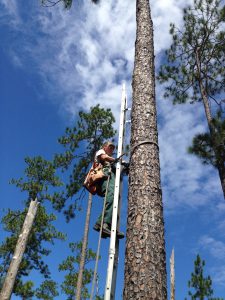
A biologist at Blackwater State Forest monitors endangered woodpecker habitat in a longleaf pine. Photo credit: Carrie Stevenson, UF IFAS Extension
In the Southeastern United States, our forests were once primarily longleaf pine-dominated ecoystems. Frequent summer thunderstorms and their accompanying lightning strikes would routinely set a portion of the forest afire. With plenty of space to move, wild animals relocated to safer portions of the forest or hunkered down in deep, winding gopher tortoise burrows underground. The longleaf pine’s life cycle has co-evolved with fire in such a way that its young growth stage is resistant to fire, and its success as a species requires fire to open up the canopy.
As human populations grew larger in the South, much of that forest land was harvested for timber, pitch, and turpentine, then cleared for agriculture and urban development. The American Southeast now has only 5% of that original longleaf pine forest. Thankfully, continued efforts led by organizations like the Longleaf Alliance and The Nature Conservancy have reminded folks of the species’ importance, and led to conservation and restoration efforts.
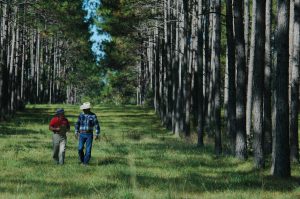
University of Florida Extension Agent surveys a planted forest with a producer in Washington County. UF/IFAS Photo: Josh Wickham.
Now, we have a newer mix of forest cover, with specimen trees preserved in parks and yards. In addition, we also have sustainable tree farms. You may have passed a wooded area where you noticed pine trees (mostly loblolly and slash in the south) were in perfect rows—these are being farmed, planted in rows just like any other crops. While they will be harvested eventually, during their lifetimes these trees fulfill all the roles we appreciate in wild forests–animal habitat, oxygen production, carbon dioxide uptake, and cooling via transpiration. The other positive of sustainable forestry is that almost as soon as they’re cut, they’re replaced. Trees are grown in a stepwise fashion to ensure there is always an available harvest. Multiple generations are grown at once to ensure there is rarely a truly bare spot in the landscape.
With 17 million acres in production, forestry makes up the largest agricultural commodity in Florida. When managing, planting, and harvesting trees, modern foresters take tree physiology, invasive species, disease outbreaks, and genetics into serious consideration. These professionals help produce necessary items for life; wood for construction, furniture, books, and the all-important toilet paper, which has emerged as a bartering item in the time of COVID-19. For more information on forestry in Florida, visit the University of Florida’s School of Forest Resources and Conservation.
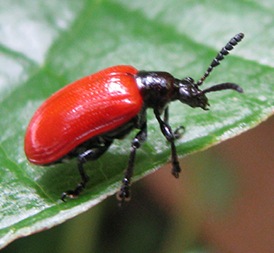
by Carrie Stevenson | Feb 18, 2020
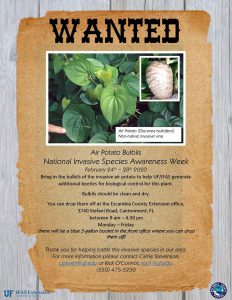
Several Extension offices in the Panhandle are collecting air potato bulbils for National Invasive Species Week. Photo credit: Esther Mudge, Escambia County
The non-native invasive air potato vine (Discorea bulbifera) has wound its way throughout Florida, from pine forests and creek floodplains to backyards. Their heart-shaped leaves are most noticeable in the spring and fall, where they can take over large areas, not unlike their fellow invasive vine, kudzu. In the fall, the plant produces a potato-like tuber called a bulbil, which grows above ground on the vine. The bulbils drop in the winter and then produce new vines the following spring.
The vine’s growth has been uncontrolled or kept back by herbicide for years, until researchers discovered a biological control insect known as the air potato leaf beetle (Liloceris cheni). In the vine’s native Nepal and China, the beetle controls growth by surviving on the leaves of the air potato, its sole food source. After extensive study, the USDA approved the use of these beetles in Florida to control the air potato vine population here. UF IFAS Extension offices statewide have participated in these beetle release programs, providing thousands of beetles to homeowners and property owners seeking to manage the invasive vine using a chemical-free technique. Left alone, air potato vines can smother full-sized trees, blocking the sunlight and causing them to collapse under the weight of the intertwined vines.
From 2012-2015, beetles were able to reduce air potato vine coverage and bulbil density by 25-70% (depending on location and density of beetle population). The active beetle-production phase of a UF IFAS grant has ended, but researchers are committed to the goal of reducing this nuisance species statewide.
To assist with this process, several Extension offices in the Panhandle are sponsoring a bulbil collection during National Invasive Species Week (NISAW, February 23-29). This effort will serve two important roles: to remove bulbils from the natural environment and to provide a seed source for university researchers seeking to grow air potato vine in a controlled environment, sustaining a continued population of air potato beetles for distribution.
For more information on Air Potato Vines and Leaf Beetles, visit https://bcrcl.ifas.ufl.edu/airpotatobiologicalcontrol.shtml or contact your local County Extension office.
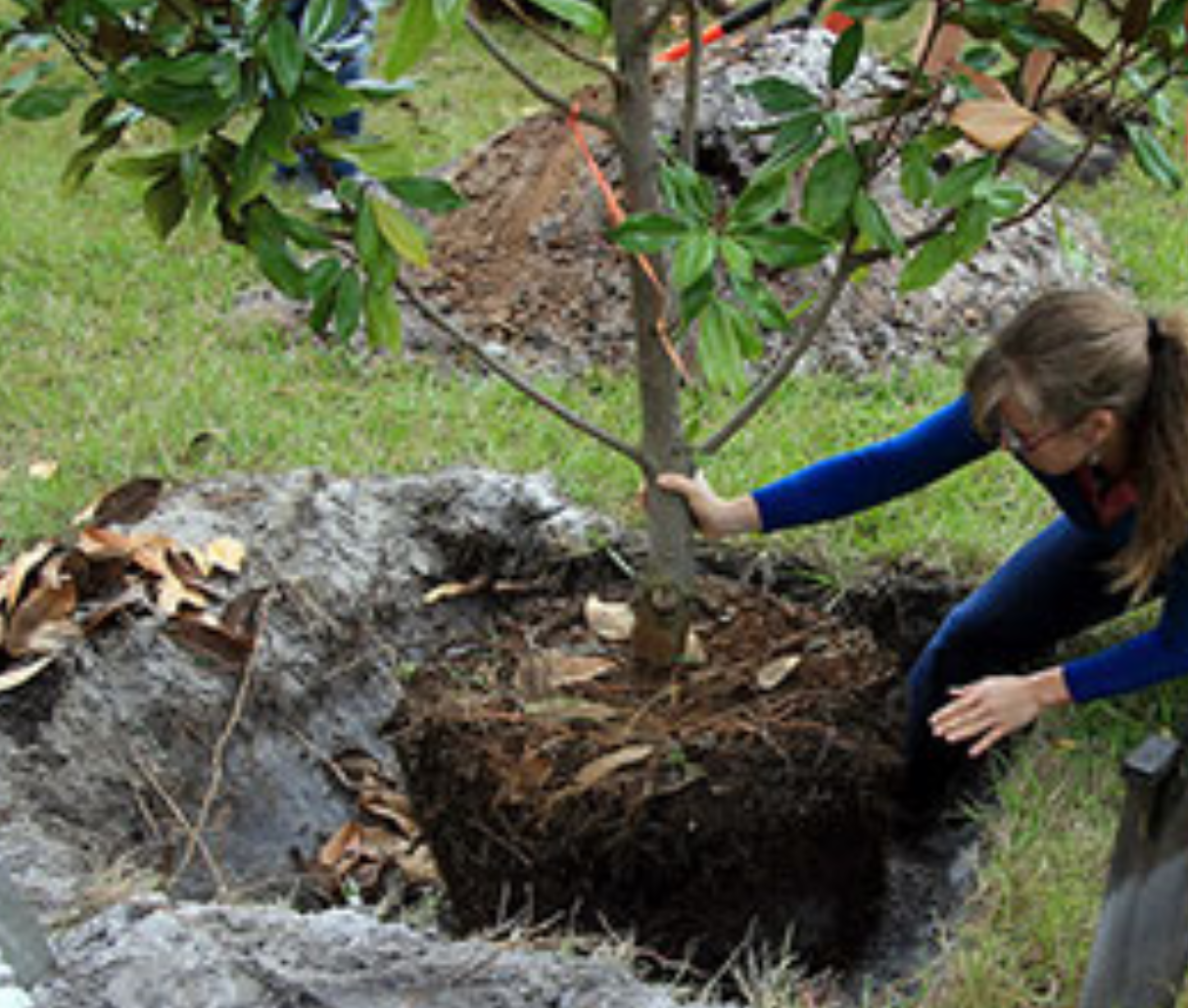
by Carrie Stevenson | Jan 22, 2020
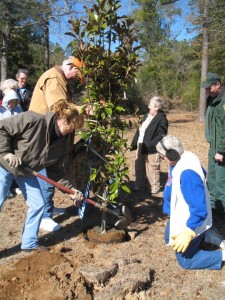
Master Gardeners demonstrate correct tree planting techniques.
Last week, we celebrated Florida’s Arbor Day. “What?” you may say—“Isn’t Arbor Day in the spring?” Well, yes and no. National Arbor Day is celebrated in the spring (April 24 this year), usually within a day or two of Earth Day. However, because of the wide range of climatic environments throughout the United States, each state has its own date based on ideal growing conditions. As it stands, Florida’s is the 3rd Friday in January, as we are situated so very far south. Alabama and Georgia, where so many of us north Floridians experience similar weather, hold their Arbor Days in late February.
Contrary to popular opinion, the optimal planting time for trees is not in the spring, but in fall and winter. Planting during dormancy allows trees to focus their energy resources on growing healthy roots. In the coming spring, a steady supply of warmth, sunshine, and pollinators will bring on leaf growth, flowers, and fruit.
Check with your local Extension offices, garden clubs, and municipalities to find out if there is an Arbor Day event near you! Several local agencies have joined forces to organize tree giveaway events and sales in observance of Florida’s Arbor Day.
Saturday, January 25th
Leon County: UF/IFAS Extension Leon County Master Gardeners will assist with the county’s Arbor Day tree planting at 9 a.m. Martha Wellman Park, 5317 W. Tennessee St., Tallahassee.














